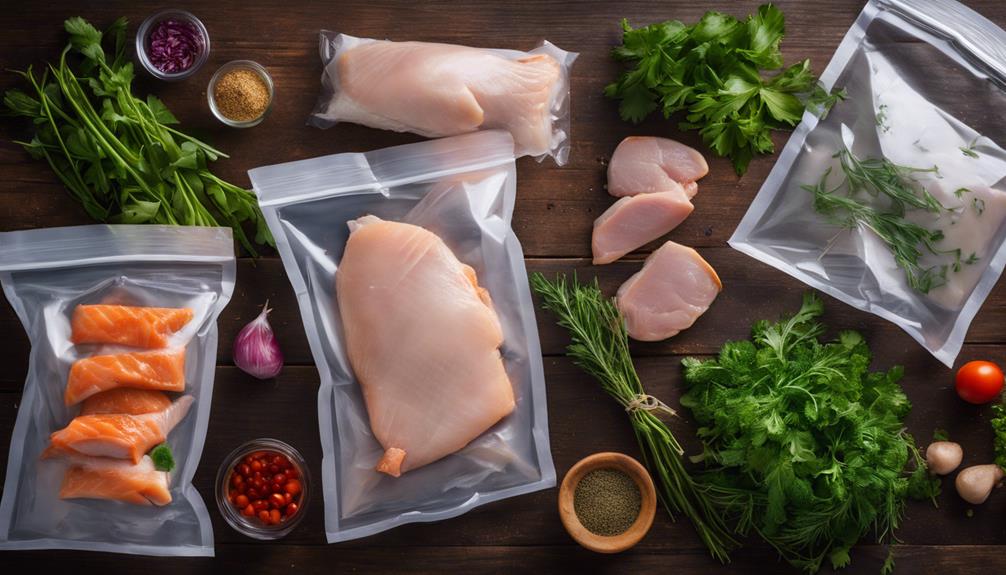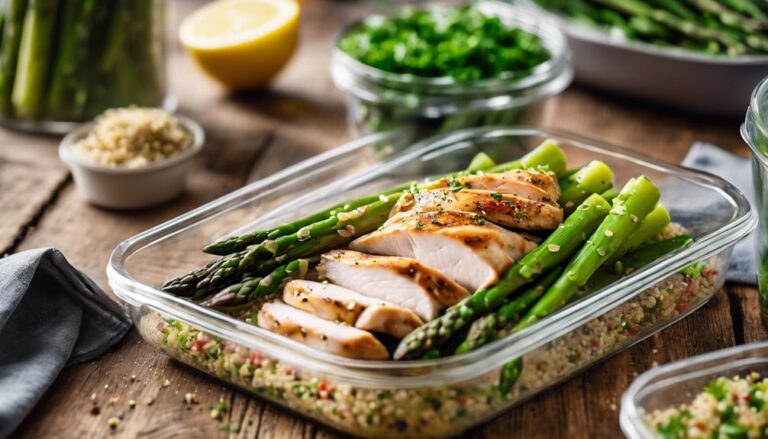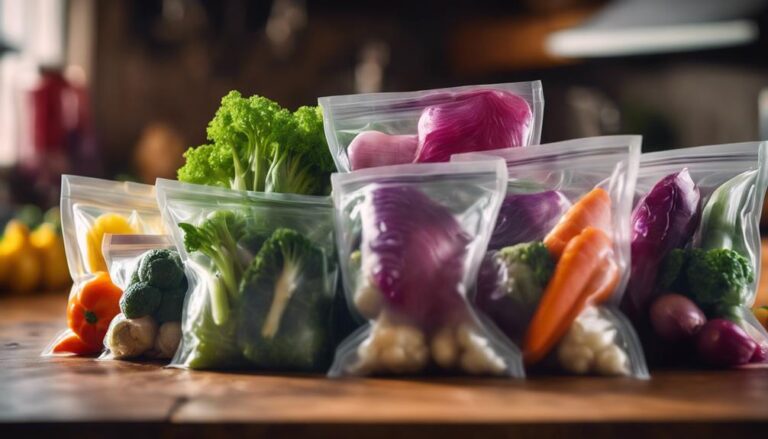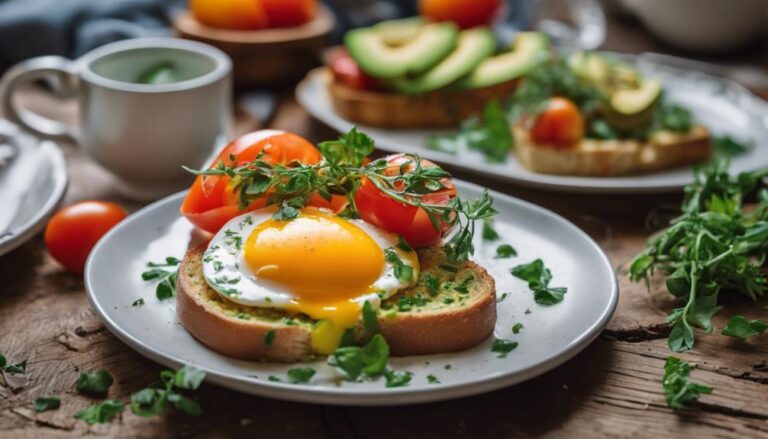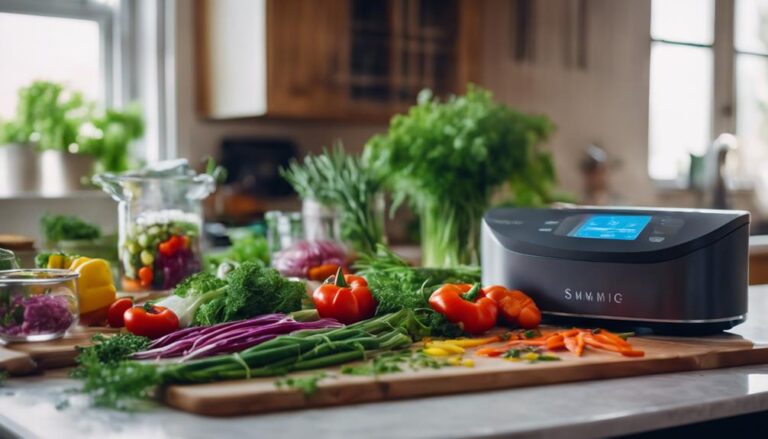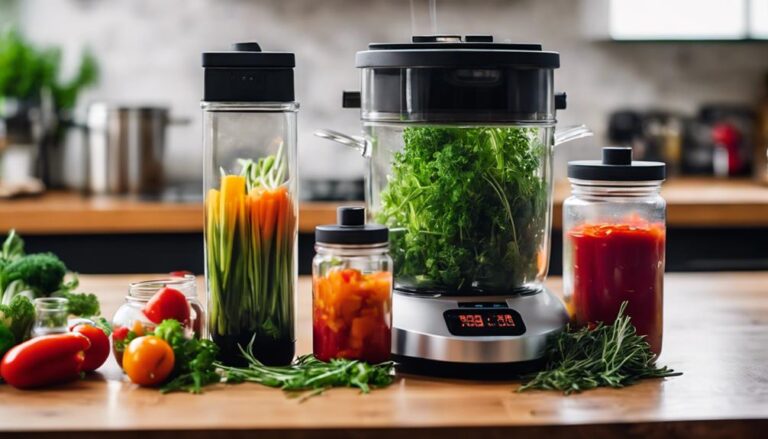The Best Lean Proteins for Sous Vide Weight Loss Recipes
I often choose lean proteins like chicken breast, turkey, and white fish for my sous vide weight loss recipes. Chicken breast packs about 31 grams of protein and low fat, making it great for reducing calories. Turkey is also a smart choice with 29 grams of protein and minimal fat. White fish, such as cod or tilapia, offers 20-25 grams of protein and healthy omega-3 fats. Sous vide cooking locks in moisture and flavor, ensuring perfect cooking while retaining nutrients. These options not only support muscle maintenance but also make meal prep easy and enjoyable. There's much more to discover about effective cooking strategies.
What You Will Learn Here
- Skinless chicken breast is an excellent choice, providing ~31g protein and low fat, ideal for weight loss and muscle maintenance.
- Turkey breast offers ~29g protein with minimal fat, making it a nutritious option for sous vide cooking and meal prep.
- Salmon is rich in omega-3 fatty acids and provides ~25g protein, promoting heart health while supporting weight loss goals.
- Lean cuts of pork tenderloin and beef (flank and sirloin) deliver high protein content and enhance meal variety without excess calories.
Overview of Lean Proteins
Lean proteins, like chicken breast, turkey, and fish, play an essential role in weight loss by providing high protein content with low fat, helping me feel full and maintain muscle.
Chicken breast is a top choice, packing about 31 grams of protein and only 3.6 grams of fat per 100 grams. This combination makes it perfect for a low-calorie diet.
Turkey also stands out, offering around 29 grams of protein while containing just 1.5 grams of fat per 100 grams. It's a great way to enjoy lean protein without adding unnecessary calories.
Fish, especially white varieties like cod and tilapia, provides 20-25 grams of protein and is low in fat as well. Some fish are even rich in omega-3 fatty acids, which are beneficial for heart health.
Incorporating these lean proteins into sous vide recipes not only guarantees precise cooking but also preserves moisture and flavor. This method allows me to enjoy delicious meals while keeping my calorie count in check.
Benefits of Sous Vide Cooking
Using sous vide cooking techniques allows me to enjoy the full benefits of lean proteins while ensuring they're cooked perfectly every time. This innovative method delivers consistent results, so I never have to worry about overcooking my chicken or fish. The vacuum sealing process not only retains moisture but also enhances flavors, resulting in meals that are both succulent and nutrient-dense.
One of the standout advantages of sous vide cooking is its ability to preserve nutrients. Cooking at low temperatures in a sealed environment means that vitamins and minerals remain intact, which is often lost in high-heat methods. Additionally, precise temperature control enhances food safety by considerably reducing the risk of undercooking proteins, a vital factor for avoiding foodborne illnesses.
The convenience factor is another game-changer. I can easily prep meals in advance and batch-cook lean proteins, making it simpler to incorporate these healthy protein sources into my diet.
Top Lean Proteins for Weight Loss
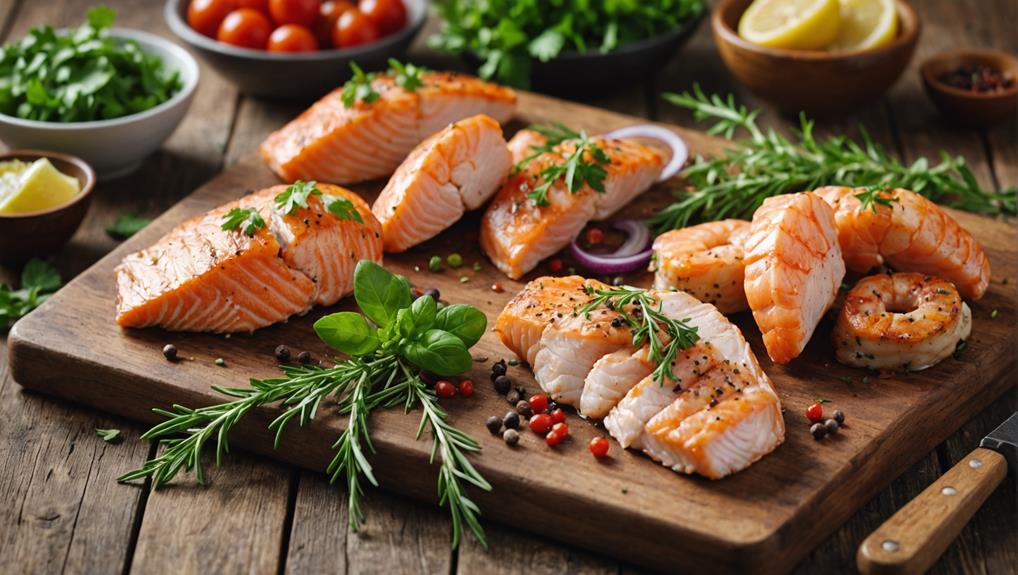
What makes certain proteins stand out for weight loss is their high protein content combined with low calories and fat, which is essential for anyone trying to shed pounds.
Chicken breast is one of my top choices, packing about 31 grams of protein per 100 grams while remaining low in fat. It's a fantastic option for anyone focused on reducing body fat.
Turkey breast follows closely, offering around 29 grams of protein with minimal fat, helping maintain muscle mass during weight loss.
When it comes to fish, I can't overlook salmon, which provides about 25 grams of protein per 100 grams and contains heart-healthy omega-3 fatty acids.
For those who enjoy pork, sous vide pork tenderloin is a flavorful option, delivering about 26 grams of protein while keeping calories in check.
Cooking Techniques for Lean Proteins
Sous vide cooking is my go-to method for preparing lean proteins, as it confirms they stay juicy and flavorful while keeping calories in check. This technique is particularly effective for chicken breast, which can easily dry out with traditional cooking methods. By immersing the chicken breast in a water bath at a precise temperature, I can guarantee even cooking and moisture retention.
Here are some essential sous vide cooking techniques I always follow:
- Temperature Control: I cook chicken breast at 147°F for one hour to achieve a tender texture that maintains its lean qualities.
- Batch Cooking: Sous vide allows me to prepare lean proteins in bulk, making meal prep a breeze and providing convenient healthy options throughout the week.
- Moisture Retention: This method minimizes the risk of overcooking, which is vital for preserving the nutritional value and taste of lean proteins.
- Simple Seasoning: I can enhance flavors without adding excess calories or fat, making sous vide ideal for weight loss recipes.
Flavoring and Seasoning Options
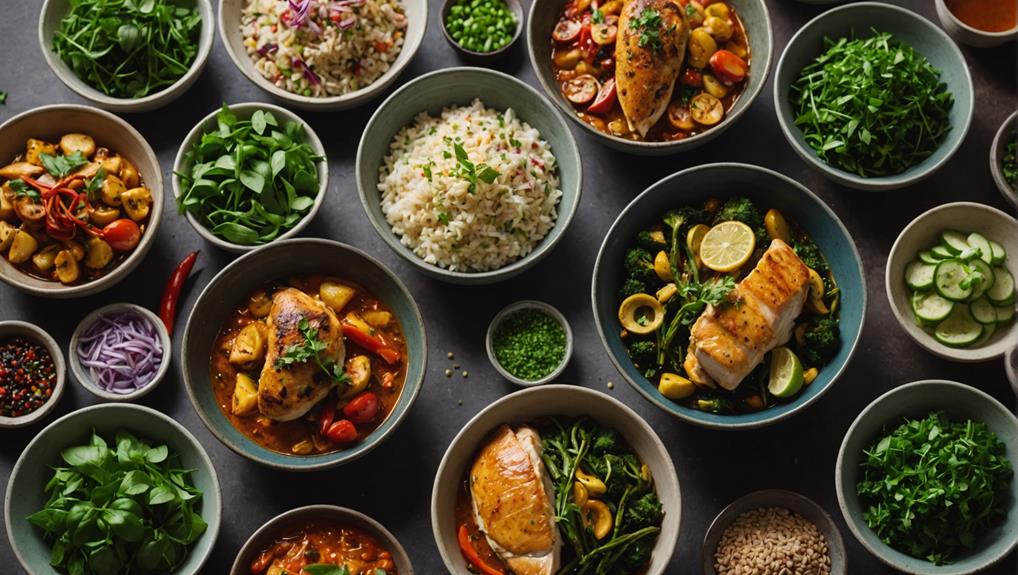
Flavoring lean proteins is essential for creating delicious, satisfying meals that align with my weight loss goals. I often start by using olive oil as a base for marinades. It adds richness without overwhelming the dish. For a simple yet effective flavor boost, I rely on salt and pepper to enhance the natural taste of the proteins.
Incorporating fresh herbs like rosemary, thyme, and basil elevates my sous vide experience without adding extra calories. I also love squeezing some lemon or lime juice over my proteins, which brings an invigorating brightness and packs a vitamin C punch.
To explore different flavors, I experiment with spices such as paprika and cumin. These can add depth and warmth, making my meals feel indulgent while still being low-calorie. Marinades with garlic, Dijon mustard, and vinegar create a robust flavor profile that keeps my palate excited.
Lastly, I occasionally use low-sodium soy sauce or tamari for that umami kick, ensuring I keep my sodium levels in check. These innovative seasoning options allow me to enjoy satisfying meals while staying true to my health goals.
Meal Prep Strategies for Success
To achieve success in meal prep, I focus on planning and organizing my lean protein options in advance, guaranteeing I always have healthy choices ready to go. Incorporating chicken breasts, turkey, pork tenderloin, and seafood into my weekly menu keeps things exciting and nutritious. Here are some strategies I use:
- Batch Cooking: I prepare multiple servings of sous vide meals at once, which saves time and reduces the temptation to grab unhealthy convenience foods throughout the week.
- Proper Storage: Vacuum sealing my cooked meals helps maintain freshness and safety. It also guarantees that the nutritional value and flavor of my proteins—like chicken breasts—stay intact.
- Seasonal Ingredients: I focus on using seasonal produce in my meals. This not only enhances flavor but also boosts the nutritional density of my dishes, making them more satisfying.
- Protein Rotation: Regularly rotating different lean proteins keeps my meals interesting and guarantees a wider range of nutrients. I find that mixing things up helps maintain my motivation and commitment to my weight loss goals.
With these strategies, meal prep becomes a seamless part of my week.
Nutritional Benefits of Each Protein

Understanding the nutritional benefits of each lean protein option helps me make informed choices that align with my weight loss goals while keeping my meals varied and enjoyable.
For instance, skinless chicken breast is a top contender, offering about 26 grams of protein per 3-ounce serving. This high protein content supports muscle repair, which is essential during weight loss.
Salmon is another excellent choice, providing 22 grams of protein and packed with omega-3 fatty acids, which are known for their heart health benefits.
Pork tenderloin also shines with approximately 23 grams of protein per serving and is low in fat, making it a smart addition to any meal plan.
Don't overlook eggs, either! They offer about 6 grams of protein per large egg and are rich in choline, aiding brain function.
Environmental Considerations in Cooking
Environmental sustainability plays an essential role in how I approach cooking, especially when preparing meals with lean proteins. By considering the environmental impact of my cooking practices, I can contribute to a healthier planet. Here are some key considerations I keep in mind:
- Opt for BPA-free bags: Using BPA-free and microwave-safe Ziploc bags helps reduce exposure to harmful chemicals during sous vide cooking.
- Choose reusable options: Instead of single-use plastic bags, I prefer reusable silicone bags. They're durable, dishwasher safe, and can withstand high temperatures, making them a sustainable choice.
- Minimize excessive packaging: Proper air removal during sous vide cooking not only enhances efficiency but also reduces the need for excessive plastic packaging.
- Source ingredients locally: Choosing seasonal and locally sourced ingredients not only supports local farmers but also lowers the carbon footprint associated with food transportation.
Future Recipe Ideas to Explore
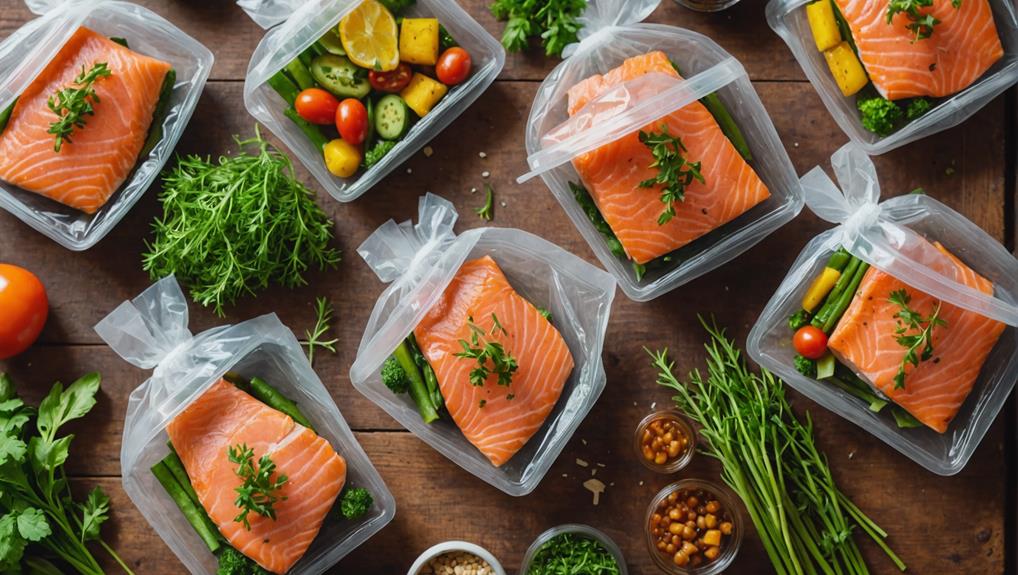
I'm excited to explore new recipe ideas that incorporate lean proteins and innovative cooking techniques, such as sous vide, to elevate my weight loss journey.
One fantastic option is sous vide turkey breast. It offers a lean alternative to chicken, providing similar protein content while being lower in fat.
For seafood lovers, sous vide shrimp and scallops are perfect choices. They're low in calories and high in protein, making them ideal for quick, nutritious meals.
Additionally, I plan to incorporate sous vide tilapia or cod into my meal prep. Both are low-fat fish rich in omega-3 fatty acids and essential nutrients, which can diversify my protein sources.
I'm also keen to experiment with sous vide lean cuts of beef, like flank or sirloin. These cuts can be perfectly cooked, creating flavorful, high-protein meals that support muscle retention during weight loss.
Lastly, I won't forget about vegetables. Sous vide preparations for asparagus or zucchini can enhance their nutritional value, making balanced, low-calorie meals that pair beautifully with lean proteins.
Each of these ideas promises to keep my meals exciting while supporting my health goals.
Frequently Asked Questions
What Is the Best Protein to Sous Vide?
When I think about the best protein to sous vide, I love sous vide chicken for its tenderness and flavor. I also enjoy experimenting with sous vide tofu, which absorbs marinades beautifully and offers a unique twist.
What Is the Best Meat to Cook in a Sous Vide?
When I think about the best meat to cook in a sous vide, I love how it enhances the sous vide flavor and texture. Chicken, pork, and salmon always turn out tender and delicious with this method.
What Are the Best Foods to Sous Vide?
When I explore sous vide, I love cooking vibrant sous vide vegetables that retain their flavor and nutrients. I also enjoy experimenting with sous vide desserts, creating delightful, perfectly textured treats that impress everyone at my dinner parties.
Is Sous Vide Healthy?
I believe sous vide is incredibly healthy. Its benefits include precise temperature control and nutrient preservation, allowing me to use innovative cooking techniques. This results in tender, flavorful dishes without added fats, supporting my health goals.
Conclusion
Incorporating lean proteins into your diet can greatly aid in weight loss, especially when using sous vide cooking techniques. This method not only preserves the nutrients but also enhances flavor without added fats.
By exploring various proteins and experimenting with seasonings, you can create delicious meals that support your health goals.
With proper meal prep strategies, you'll find it easier to maintain a balanced diet.
Ultimately, embracing these practices can lead to long-term success in your weight loss journey.
